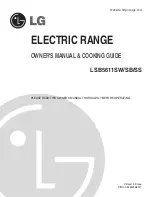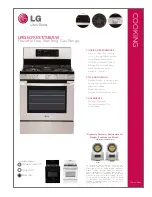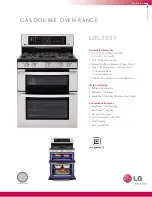
Care and Cleaning
27
General Cleaning
Refer to the table at the beginning of this chapter for more
detailed information about cleaning specific parts of the range.
Before manually cleaning any part of the range, be sure all
controls are turned off and the range is cool. The range may be
hot and can cause burns.
Ammonia must be rinsed before operating the oven. Provide
adequate ventilation.
Aluminum Foil, Aluminum Utensils, and Oven
Liners
Never cover any slots, holes, or passages in the oven bottom or
cover an entire oven rack with materials such as aluminum foil.
Doing so blocks air flow through the oven and may cause carbon
monoxide poisoning. Aluminum foil linings may trap heat,
causing a fire hazard.
Protective liners—Do not use aluminum foil to line the oven
bottom. The high heat of the oven can melt these materials to the
oven cavity and ruin the oven. These types of materials can also
reduce the effectiveness of the air circulation in the oven and
produce poor baking results. Only use aluminum foil as recom-
mended in this manual. Improper installation of these liners may
result in risk of electric shock or fire.
•
Aluminum foil
- Use of aluminum foil on a hot cooktop can
damage the cooktop. Do not use thin aluminum cooking
utensils or allow aluminum foil to touch the surface burners
under any circumstances.
•
Aluminum utensils
- The melting point of aluminum is
much lower than that of other metals. If aluminum pans are
allowed to boil dry when using the cooktop, the utensil will
be damaged or destroyed.
•
Oven racks
- Do not use aluminum foil to cover the oven
racks. During self clean the oven temperature can become
hot enough to melt aluminum cooking utensils or aluminum
foil and could result in permanent damage to the oven
interior and porcelain finish.
Cleaning the Glass Cooktop
To avoid possible burns do not attempt any of the cleaning
instructions provided below before turning off all surface
burners and allow them to cool.
Your cooktop is glass with gas sealed burners. To clean
the glass portion of the cooktop follow these directions.
For light to moderate soil:
Apply a few drops of cooktop cleaning cream directly to
the glass part of the cooktop. Use a clean paper towel to
clean the entire cooktop surface. Make sure the cooktop
is cleaned thoroughly, leaving no residue. Do not use the
towel you use to clean the cooktop for any other purpose.
For heavy, burned on soil:
Apply a few drops of cooktop cleaning cream directly to
the soiled area. Rub the soiled area using a non-abrasive
cleaning tool, applying pressure as needed. Do not use
the pad you use to clean the cooktop for any other
purpose. If soils remain, carefully scrape soils with a
metal razor blade scraper, holding scraper at a 30 degree
angle to the surface (Figure 26). Remove loosened soils
with cooktop cleaning cream and buff surface clean.
Figure 25: Cleaning agents to avoid
BLEACH
ABRASIVE
CLEANERS
AMMONIA
Figure 26:
Use razor to scrape sediment on glass
surface
30°










































